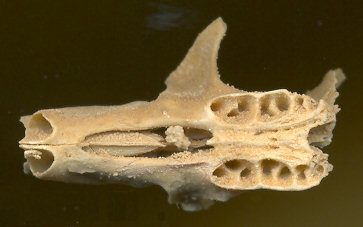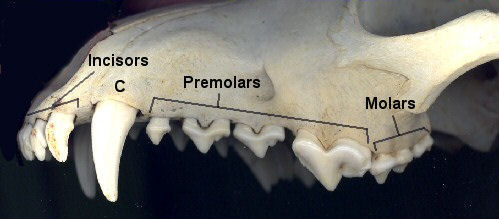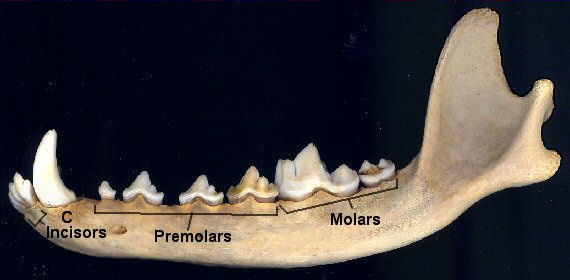Mammals, along with some other vertebrates, have thecodont dentition; that is, the teeth are set in sockets (known as aveoli) in the jaw bones. 
The figure is a palatal view of a fossil Neotoma (packrat). The alveoli for the paired incisors are seen on the left; on the right, the alveoli for the three pairs of molars can be seen. Within the alveoli, the deeper spaces for the molar roots are visible. Even in the absence of teeth, the number of teeth and, often, some idea of the taxon involved is possible from the alveoli alone.
Mammals are heterodont (for the most part), primitively having incisors (I), canines (C), premolars (P), and molars (M) recognizably different from each other. By the late Cretaceous or early Cenozoic, tooth formulas had standardized to a maximum of 50 for marsupials and 44 for placental mammals. These numbers and the distribution of the various tooth types are recognized as the primitive tooth formulas for the two groups.
Tooth formulas are given in various ways, but generally easily recognizable. Marsupials had a primitive tooth formula of I 5/4 (that is, 5 upper and 4 lower on each jaw), C 1/1, P 3/3, and M 4/4 = 25; doubled (for the two sides) gives the total number of teeth as 50. The abbreviations for the various tooth types frequently is omitted since they always are given in the same order.
The tooth formula for placentals is 3/3 1/1 4/4 and 3/3 = 22. Doubled for the two sides gives the primitive number of 44. Teeth are numbered according to the primitive formula, from front to back with each type starting over with "1". Thus in placentals, I1/i1 I2/i2 I3/i3 C1/c1 P1/p1 P2/p2 P3/p3 P4/p4 M1/m1 M2/m2 M3/m3. Various conventions to indicate uppers and lowers are used; in the example, an upper case letter indicates an upper tooth and a lower case letter a lower tooth. Sometimes superscripts and subscripts are used and sometimes a slash behind (e.g., P4/ for upper premolar 4 and /P4 for the lower).
Most mammals have reduced their dentition evolutionarily. The number system of teeth is retained even when teeth are lost. Teeth that are lost evolutionarily usually are lost at the ends of the functional rows: Thus commonly incisors are lost from the outer parts (first I3, then I2, etc.), premolars from the front (P1, then P2, etc.), and molars from the back (M3, then M2, then M1). As an example, our human tooth formula is 2/2, 1/1, 2/2, 3/3 = 16 X 2 = 32; we have lost I3, and P1, P2. When tooth types are lost entirely, as in many mice and rats, the absent ones generally are indicated by zeros. Thus the tooth formula for a house mouse is 1/1 0/0 0/0 3/3 (that is, they have no canines and no premolars). Often, but not always, there is a space left where teeth have been lost; such a space is a diastema. For example, there is a long diastema between the incisors and the molars in the house mouse.
In most cases, the morphology of each class of teeth is unique. Most likely to be confused are premolars and molars. Premolars usually are simpler and generally are two-rooted whereas molars generally have more than two roots. In some mammals, one or more of the premolars take on the function and appearance of molars—a condition called molarization. Horses are an extreme case, where P2-M3 form a dental battery with the premolars almost identical to the molars.
Even in the horses, however, there is one major difference. Mammals are diphyodont—that is, they have two generations of teeth, whereas in other tetrapods, teeth normally are replaced an indefinite number of times. In placentals, only the incisors, canines, and premolars are replaced. The first generation consists of deciduous teeth (lacteal teeth, milk teeth, baby teeth) and eventually are replaced by permanent teeth. In marsupials, only P3 is replaced. Deciduous teeth when abbreviated are preceded by "D" (upper) or "d" (lower); thus the last lower, deciduous premolar in a placental is designated as dp4.

Upper dentition of a dog. Canines have 3 incisors, 1 canine, 4 premolars, and 2 molars on each side of the upper jaws. In the Carnivora, the 4th upper premolar is the upper carnassial that, together with the lower 1st molar forms the carnassial pair.

Lower dentition of a dog. Most canines have 3 incisors, 1 canine, 4 premolars, and 3 molars on each of the lower jaws. This particular specimen is missing the 3rd molar.
Last Update: 27 Dec 2007
Centennial Museum and Department of Biological Sciences, The University of Texas at El Paso